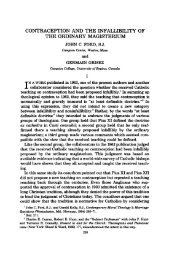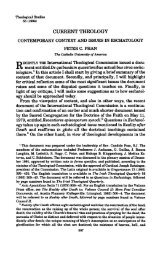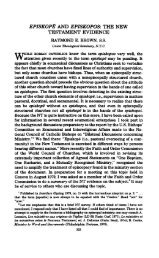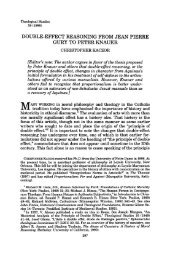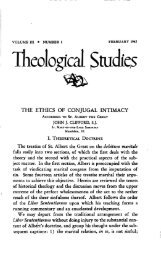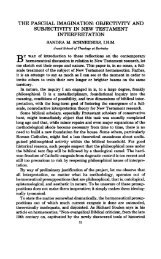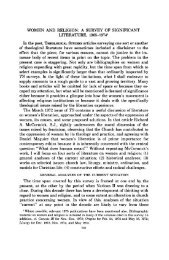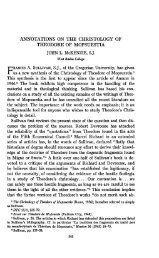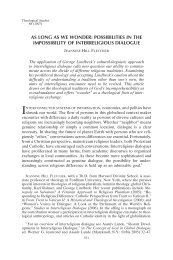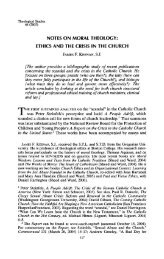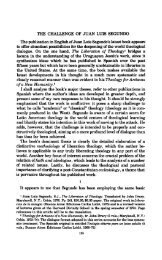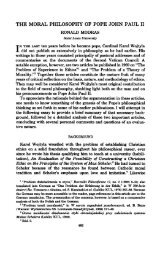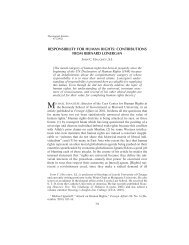SYMBOL, MYTH, AND THE BIBLICAL REVELATION AVERY ...
SYMBOL, MYTH, AND THE BIBLICAL REVELATION AVERY ...
SYMBOL, MYTH, AND THE BIBLICAL REVELATION AVERY ...
Create successful ePaper yourself
Turn your PDF publications into a flip-book with our unique Google optimized e-Paper software.
<strong>SYMBOL</strong>, <strong>MYTH</strong>, <strong>AND</strong> <strong>THE</strong> <strong>BIBLICAL</strong> <strong>REVELATION</strong> 9<br />
the god or gods are clearly recognized as being persons. Myth, being<br />
essentially vague and closely bound to imaginative thought, would be<br />
incapable of conveying a definite judgment about whether the transcendent<br />
is ultimately personal. But the forces behind the world are at<br />
least depicted as if they were persons.<br />
In a wider sense, the concept of myth can be extended to include<br />
impersonal agencies, provided these are hypostatized. In this looser<br />
usage, one may speak of the myth of inevitable progress or the myth<br />
of democracy. But since the personal reference is lacking, we do not<br />
have myth in the strict sense. If a force such as progress is portrayed<br />
as a god or goddess, this can only be by the merest artifice. 14<br />
5) The transcendent figures of the mythical world are represented<br />
as taking part in activities on a cosmic scale, which exert a permanent<br />
causal influence on earthly happenings. Each particular myth aims to<br />
account for a whole series of recurring phenomena, such as the rhythm<br />
of the seasons, the variations of weather, the alternation of night and<br />
day. To all such events one may apply what McKenzie says of the<br />
fertility gods: "The gods of fertility are not merely symbols of natural<br />
forces; the succession of phenomena depends on the perpetual lifedeath<br />
cycle on a cosmic scale, and these gods make the cycle." 15<br />
6) The cosmic event is expressed in the form of a story, a drama<br />
which unfolds in a dimension of duration quite removed from time as<br />
we experience it. As Eliade says, "mythic or sacred time is qualitatively<br />
different from profane time, from the continuous and irreversible<br />
time of our profane existence. . . . The myth takes man out of his own<br />
time—his individual, chronological, 'historic' time—and projects<br />
him, symbolically at least, into the Great Time, into a paradoxical<br />
instant which cannot be measured because it does not consist of duration."<br />
16 Through cultic action the mythical events are brought to<br />
bear upon particular earthly situations.<br />
The time dimension proper to myth is of great importance in distinguishing<br />
myth not only from static types of symbolism (such as a<br />
14 In his polemic against Bultmann, Barth insists on the permanence of myth in the<br />
modern world—a point he proceeds to exemplify by referring to "the myth of the twentieth<br />
century, the Marxist myth, the myth of the Christian West, etc." But are these properly<br />
myths? Cf. H. W. Bartsch (ed.), Kerygma and Myth 2 (London, 1962) 109.<br />
18 McKenzie, art. cit. } p. 190.<br />
16 M. Eliade, Images and Symbols (New York, 1961) pp. 57-58.



